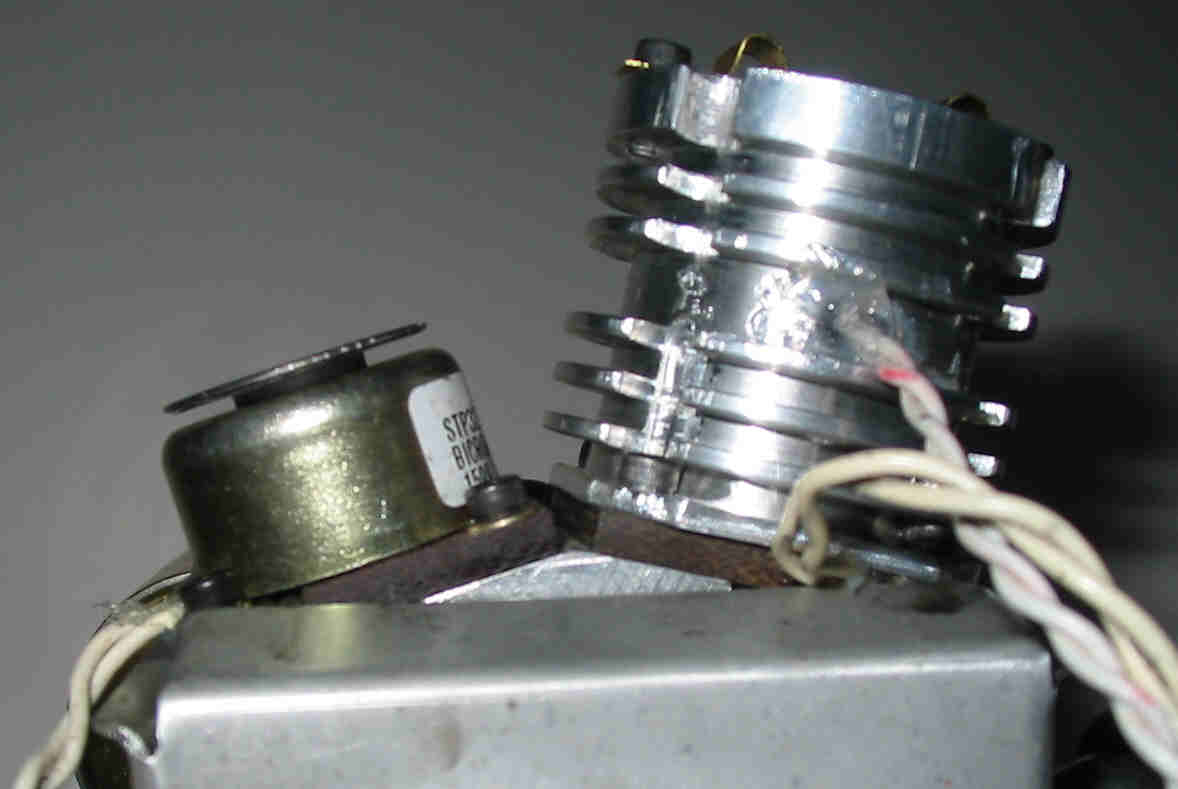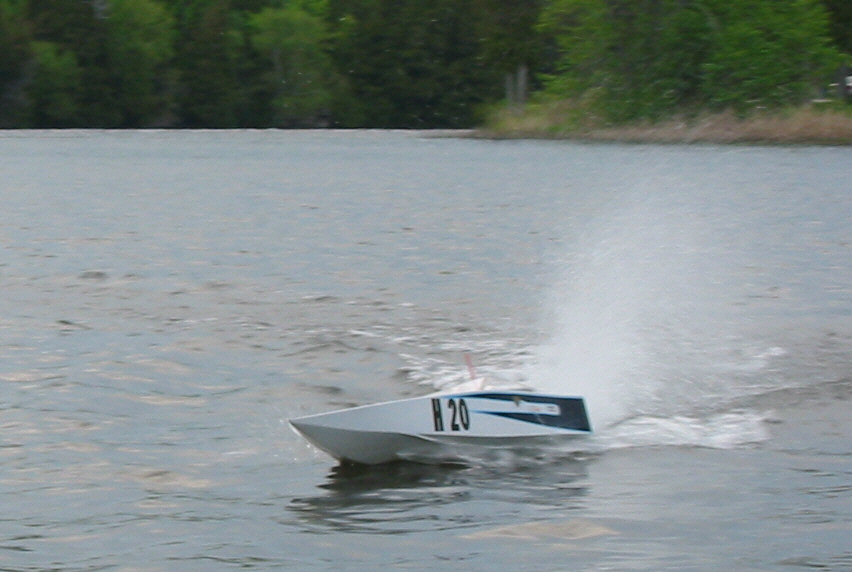My second EVIC engine, the EVIC - 111 Mk2
Electronic Valve Internal Combustion - 1 cylinder 1" bore
1"stroke
4 Stroke Cycle I.C. Engines with Electronically Activated Valves.

The EVIC - 111 Mk2 Engine, with
ganged solenoids on both valves, in my R/C Boat. September
2003.
Development started on the EVIC - 111 Mk2 engine in September 2001. The Mk2 is a lighter engine with an all aluminum crankcase and an improved head. My plan, from the outset, was to put this engine into a radio controlled model boat to demonstrate that an engine with solenoid actuated valves could develop useful power. I am an electrical engineer and my knowledge of small engines and small engine design is limited. I received valuable advice from many builders of both small and larger engines that pointed to a need for an improved the head design.
 This advice led to a new
head with new valve/solenoid assemblies. This head was
tested on the Mk1 engine in March of 2002, before this MK2 engine was completed. The same small Bicron
STP2416-014 solenoid still operated the intake valve. The
larger STP3220-014 solenoid operated the exhaust valve. The
exhaust valve was smaller, 0.380" versus 0.400" in diameter for the
Mk1 engine allowing the exhaust valve lift to increase to 0.025". Although the intake valve was larger, 0.420" versus
0.400", the lift was increased to 0.030". On
March 7, 2002 an unloaded top speed of over 10,000 RPM was recorded. With this encouraging result the Mk2 engine was quickly
completed.
This advice led to a new
head with new valve/solenoid assemblies. This head was
tested on the Mk1 engine in March of 2002, before this MK2 engine was completed. The same small Bicron
STP2416-014 solenoid still operated the intake valve. The
larger STP3220-014 solenoid operated the exhaust valve. The
exhaust valve was smaller, 0.380" versus 0.400" in diameter for the
Mk1 engine allowing the exhaust valve lift to increase to 0.025". Although the intake valve was larger, 0.420" versus
0.400", the lift was increased to 0.030". On
March 7, 2002 an unloaded top speed of over 10,000 RPM was recorded. With this encouraging result the Mk2 engine was quickly
completed.
Development work on the Mk2 engine has continued through 2002 and 2003. A radio control interface was developed for the "Electronic Throttle" and the engine installed in a 52" deep V model boat. To eliminate the valve bounce that resulted from increasing the valve lifts, a dual processor configuration was developed. A PIC12C508A processor provided electrical damping to slow the valves down just before the reached the valve seats. The boat hit the water for the first time on June 27, 2002. It ran but the speed was disappointing.
Over the summer the compression ratio was increased from 8:1 to 10.5:1. A new carburetor with a larger venturi was fitted. Improvements were made to the software. Some water cooling was added to the head. By September the engine was turning an Octura X462 prop at ~ 7500 RPM, up from about 5000 RPM in June. A larger solenoid, the same size as the one on the exhaust valve, was now operating the intake valve with a 0.045" lift. Engine acceleration under load continued to be poor.
Design weakness showed up. The engine overheated. The oil wouldn't stay in the crankcase. The connecting rod bearings failed. The piston seized. However solutions were found and Have been incorporated into Revision 4 of the EVIC-111 Mk1 book. Details can be found in the design Updates on this web site.
 When cooler weather
arrived, I put the boat away and tackled the acceleration problem. I now knew the cause. Attempts to
accelerate with even moderate loads resulted in the exhaust valve failing to
open. A design break through occurred when I ganged
two solenoids on the exhaust valve. Tests showed that
a flat faced solenoid with a stroke ~ 1/3 of the desired valve lift combined
with a similar sized cone faced solenoid with a stroke equal to the valve lift
would open the exhaust valve quickly and give a 0.045" valve lift. A new dual processor Mk4 Electronics Package was
developed to control this 3 solenoid configuration. Power
output increased to 0.4 hp at 8000 RPM with this configuration.
When cooler weather
arrived, I put the boat away and tackled the acceleration problem. I now knew the cause. Attempts to
accelerate with even moderate loads resulted in the exhaust valve failing to
open. A design break through occurred when I ganged
two solenoids on the exhaust valve. Tests showed that
a flat faced solenoid with a stroke ~ 1/3 of the desired valve lift combined
with a similar sized cone faced solenoid with a stroke equal to the valve lift
would open the exhaust valve quickly and give a 0.045" valve lift. A new dual processor Mk4 Electronics Package was
developed to control this 3 solenoid configuration. Power
output increased to 0.4 hp at 8000 RPM with this configuration.
 This configuration was
tested was tested in my R/C boat on May 29, 2003. The
increased power and better acceleration was evident as the engine turned a
larger Octura X465 propeller at 7500 RPM. During the summer of 2003 I attempted to get more power by
ganging 2 solenoids on the intake valve and installing stronger valve springs
on both valves. The intake valve is opening and
closing faster and has higher lift, 0.060". The
exhaust valve is closing faster. The result has been a
small improvement in power output. Work continues to
improve this engine's power output.
This configuration was
tested was tested in my R/C boat on May 29, 2003. The
increased power and better acceleration was evident as the engine turned a
larger Octura X465 propeller at 7500 RPM. During the summer of 2003 I attempted to get more power by
ganging 2 solenoids on the intake valve and installing stronger valve springs
on both valves. The intake valve is opening and
closing faster and has higher lift, 0.060". The
exhaust valve is closing faster. The result has been a
small improvement in power output. Work continues to
improve this engine's power output.
The Mk2 engine proved to be more reliable this year than last. I did have some crankshaft problems and in September I discovered that the crank pin was bent. As a result I made and installed a new stronger crankshaft and connecting rod. See Update #18 for details.
In April 2004 I updated the EVIC - 111 book to incorporate all the things learned in 2003. Most of my development in 2004 was aimed at improving the reliability and performance of my EVIC Twin.
In the spring of 2005 I pushed the top speed of my Mk2 engine to over 15,000 rpm. However the engine was not reliable and the test results were not easily duplicated. As a result a new crankcase with a stronger crankshaft was designed and built. I followed this with a new Mk3 head with larger valves. New solenoid assemblies with lighter solenoid armatures are being constructed and will be tested in late 2005 and 2006. If all goes as planned, an improved head for the EVIC Twin will follow.
Last update - November 21, 2005.